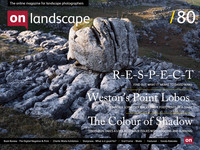Walk Softly and Leave no Trace?

David Ward
T-shirt winning landscape photographer, one time carpenter, full-time workshop leader and occasional author who does all his own decorating.
Prior to venturing out onto a sandy shore or through pristine snow with a group of photographers I often give them a little advice about tripod rage. This is a serious problem that can result in bruised egos or (in the worst cases) physical bruises, abrasions or even concussion. A minor downside of being on location with seven or eight fellow photographers is that they can sometimes crop up in your field of view. This isn’t usually too serious a problem; most are amenable to a kind request to move along. If they’re not you can always resort to the clone tool, Adobe’s humane method of removing people from your photographs. They might feel a little faint (or perhaps feint) whilst you do it, but at least no blood has been shed. If the location is covered in snow, however, cloning becomes something to be avoided – even for content aware Phil. Better by far to try and keep off the snow until you are absolutely certain that others are done and that you need to tread on it in order to reach the point where you want to make your photograph. Otherwise tripod rage might rear its ugly head as one participant treads on another’s pristine foreground.
Featured Comments From:
Michael SA: Thanks David. Something I have wondered about is hillwalking where this causes damage/erosion. Plenty of mountains now have well trodden paths, and every extra set of footsteps adds to the problem, in some cases creating horrible eyesores. Should we avoid these paths? And what if there is only one safe route (e.g. along a ridge)?

